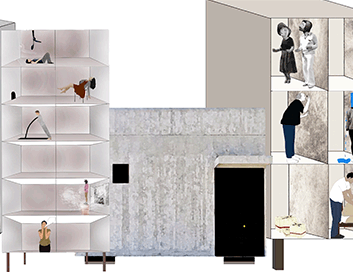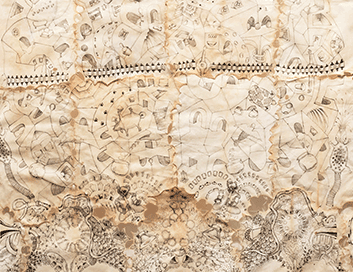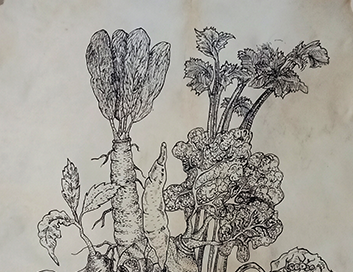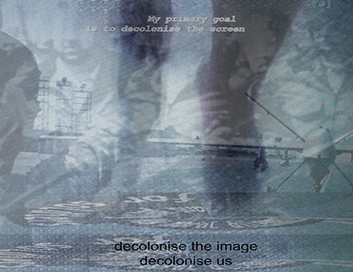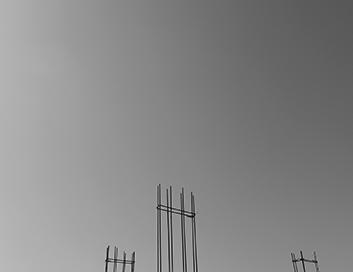Afrah Shafiq (b.1989) is a multi/new media artist based between Goa and Bangalore. Her art practice moves across various platforms and mediums, seeking a way to retain the tactile within the digital and the poetry within technology.
Her work has been shown at the Lahore Biennial 2020, testsite Austin, Kochi Muziris Biennale 2018/19, The Guild Art Gallery in Alibaug, Be.Fantastic in Bengaluru, What About Art in Mumbai, Digital Grafitti Festival in Florida, The Fusebox Festival in Texas and the Computer Space festival in Bulgaria.
She has been invited on research and residency programs with Fluent Collaborative Austin, the Liverpool Biennial of Contemporary Art, and the Institute of Advance Studies in Nantes, France.
When she is not glued to her computer she also makes glass mosaic.
Anoli Perera Sri Lanka’s leading artist, Anoli Perera was born in Colombo and has a degree in political science, economics and sociology from the University Of Colombo, Sri Lanka, followed by a postgraduate diploma in International Affairs. She then lived in the USA between 1988 and 1992 where she took part in art education programmes at Santa Barbara City College, California and the ‘Artworks’, a program for continuing art education at Princeton, New Jersey. She currently works as a painter, sculptor and installation artist based in Colombo, Sri Lanka, and Delhi, India. As a writer, she has contributed consistently to bring visibility to contemporary art in Sri Lanka. As a founding member of Theertha Artists Collective she has played an instrumental role as an institution builder, supporting her peers in revitalizing the arts in Colombo through strategic programming, workshops and international collaborations. Her own aesthetic interventions — political, personal and feminist — ushered in a new wave of art making in Sri Lanka from the 1990s onwards.
Anoli Perera has deployed her work to present contradictory as well as complex narratives that emerge when living in contemporary society, processed through an artist’s perception. Tapping her personal family histories and her own existence in a particular historical moment that allows her to see the extremities of two eras, Perera intimately looks back and forth into memory, nostalgia, dispositions of home/family, mass migrations, borders, women’s space, urbanity and dystopia. Her extensive series of works such as ‘Memory Keeper’, ‘Long Walk’, ‘Logbook of Absence’ and‘Left Behinder’ brings to surface the fragility, selective recollections and manipulations of memory. Her early works such as ‘Dinner for Six’ and ‘Comfort Zones’ investigated the intriguing and coercive roles imposed upon women by the cultural discourse of family. She re-looks at the systems of value given to their creativity within homemaking critically and intimately. Her exhibition, ‘The City, Janus Faced,’ presented a series of works which explored the narratives on urbanity, city and its chimera. Perera’s current art practice includes painting, sculpture, installation art, and video and photo- performances. Her work incorporates the concept of ‘bricolage’ where fragments from different written texts, raw materials, objects and painted surfaces are juxtaposed together giving a textured surface. At present, she uses cloth, thread, lace and paper as raw material for her sculptures and installations. Perera’s art practice emphatically celebrates the making of labour-intensive art works, an exercise in which she locates herself in the intermediate zone between craft and art. She weaves, by placing or by suturing a single unit piece by piece together, as if she were solving or making a puzzle carefully. At its completion, she leaves a sense often tativeness on the work in terms of the possible visual pleasures that the work can offer to its viewers.
Anupam Roy’s practice reflects his experiences and observations in the hinterlands of rural Bengal where he was born in 1985, the urban landscapes of metropolitan Delhi where he currently lives and works, as well as in Central and North Eastern India where he has engaged in regional political inquiry and activism. Roy studied contemporary art at Ambedkar University, Delhi. His works have been exhibited at several exhibitions including the 2018 Triennial: Songs for Sabotage, New Museum, New York, and he is the recipient of the 2018 FICA Emerging Artist Award.
Roy has a parallel practice as a designer of political posters, signage, and graffiti. He has conducted numerous workshops on the design and conception of political posters with radical political and activist groups all over India.
Bhagwati Prasad works with drawing and performance. He conducted extensive research with Sarai-CSDS on Delhi’s popular culture, water wars, and media life (2002-12), and his books include ‘Tinker. Solder. Tap.’ (Co-authored, 2009) and ‘The Water Cookbook’ (2010). He is known for his large scale-wall drawings, notably at Jaipur Kala Kendra (2018), and his ‘Hashtag series’ has proliferated on social media since 2017. He has performed at the Shanghai Biennale (2017) and Serendipity (Goa, 2017). He has been part of many local and international residencies, and was the recipient of IFA’s Artist Practice Grant (2015). His most recent work Begumpura Series, in which he revisits the egalitarian imaginary of saint Ravidas, showed at MACBA, Barcelona, in 2018-19. and The Stutter of Food presented at Five Million Incidents at Goethe-Institut, Delhi, in 2020. An interview with him was recently published in the drawing journal Fukt (Berlin, 2019).
Chandan Gomes has studied Philosophy at St. Stephen’s College, Delhi (2009). Emotional and intellectual anxieties drive him as a photographer.
Chandan is the recipient of the India Habitat Centre Fellowship for Photography in 2011, Oslo University Scholarship to participate in Chobi Mela in 2012, Neel Dongre Award in Photography in 2013, the Foto Visura Spotlight Grant in 2014 and the INK Fellowship in 2016. He was nominated for the Prix Pictet Award in 2015 and the Sovereign Asia Art Prize in 2018.
His artist book, ‘This World of Dew’, published by PHOTOINK, was released in 2015 and went on to garner critical acclaim. ‘This World of Dew’ has been shown at the Benaki Museum, Athens, Parc Des Ateliers, Arles and Zeytinburnu International Photography Festival, Istanbul, amongst other places. His photo essay ‘There are things I call home’ was on view at Asia Society Center, Texas as part of FotoFest 2018 Biennale, Houston. He exhibited his latest body of work ‘People You May Know’ at Les Recontres d’Arles in July, 2018 as part of the prestigious New Discovery Award; the exhibition was supported by PHOTOINK. Chandan has also exhibited at Kochi-Muziris Biennale 2018 and Serendipity Arts Festival 2018. He was amongst the three finalists in the visual arts category for the Art Spectrum South Asia Awards 2019. Chandan was invited to Centre for Documentary Studies, Duke University to exhibit his work and run workshops on book making and narrative building.
He currently teaches at the Sri Aurobindo Centre for Arts & Communications, Delhi and Ashoka University, Haryana.
Gautam Kansara is an artist and educator formerly based in Brooklyn, New York, and recently relocated to Zürich, Switzerland. Crossing mediums between video, photography, and installation, Kansara’s work is part of prestigious private collections including The Burger Collection, Hong Kong, and The Shreya and Swapan Seth Collection, New Delhi. Since 2002 his works have been featured internationally at the Asia Society Museum (New York), Bronx Museum of the Arts (New York), Haus der Kulturen der Welt (Berlin), British Film Institute (London), Shrine Empire Gallery (New Delhi), LMAK Gallery (New York), and Secret Project Robot (Brooklyn). Gautam has been an artist-in-residence at Smack Mellon, Lower Manhattan Cultural Council’s Workspace (2017) and Swing Space (2006), and the Center for Book Arts, all in New York City. Gautam has a Bachelor of Arts degree with a major in Studio Arts from the University of California, Santa Cruz, as well as a Master of Arts degree from New York University’s Department of Arts and Arts Professions. Recently Gautam was included in the inaugural alumni exhibition for New York University’s Department of Art and Art Professions, which was curated by Chrissie Iles, the Anne and Joel Ehrenkranz curator at the Whitney Museum of American Art, New York.
Gautam has been Nominated for Swiss Art Awards, organized annually by the Swiss Federal Office for Culture, Switzerland, he has been selected for a solo presentation during Art Basel 2020.
Through video, photography, and installation Kansara produces works that draw upon personal history and current events in order to examine the layering of personal and collective memory, family dynamics, and cultural displacement. Kansara uses an arsenal of analog manoeuvres and gestures to alter and obscure documentary based recordings. Documentation and archiving are at the core of Kansara’s work. Recording himself and his family as source material has often been where he’s started. And this practice, this desire to record and then re-watch, re-edit, and re-position is rooted in the question of how to negotiate the experience and the memory with the archive and the documentation.
Katyayini Gargi (b. 1990) graduated with a Bachelor in Painting from M.S.U., Baroda followed by a Masters in Fine Art from Central Saint Martins, London. She works with multiple mediums including painting, sculpture, animation and music/sound. She lives and works in Delhi.
The Centre does not hold is borrowed from W.B. Yeats’s widely read poem, The Second Coming. Yeats began writing this in January 1919, in the wake of the First World War, the Russian Revolution, and political turmoil in his native Ireland. Yet, the poem captures more than just political unrest and violence. Its anxiety concerns the social ills of modernity: the rupture of traditional family and societal structures; the loss of collective religious faith, and with it, the collective sense of purpose; the feeling that the old rules no longer apply and there’s nothing to replace them.
Katyayini Gargi appropriates this term to describe the personal, to interrogate one’s relationship to a sense of stability. As we open up to the world around us and come out of our proverbial shells, we are left with a sense that all social, political, environmental and familial structures that we often take for granted lie on shifting, precarious grounds. Furthermore, these pillars of so-called stability can also become an impediment, should we try to surpass them. The artist regards the chaos that this unleashes to be ultimately cyclical, as she too occupies a transitory space currently; just as Yeats’s words held relevance to Joan Didion in the 1960s as she wrote, “the center will not hold” in Slouching Towards Bethlehem, while describing a social disaster. Con(Temporary Living), Daawat (table for 9) and Carried a House consider the same premise while also contemplating longing. The expectations that revolve around objects: as one moves from place to place, a light-weight, waterproof tent, or that placed upon the lonesome table, with the ability to feed nine comfortably, now lying unused and dysfunctional. Carried a House is more personal as it unpacks the expectations often placed upon women be homemakers, in maintaining some sense of stability as the world shifts beneath their feet.
Omer Wasim & the late Saira Sheikh are visual artists who practice together, and cast a retrospective glance at the present to radically examine and mine contemporary art practices, and recent, albeit superficial, interest of the global west in their region; and also to reconfigure, re-articulate, and disrupt existing and complacent modes of artistic engagement and production. Wasim continues to execute projects that were jointly conceived with Sheikh. Wasim (b. 1988) has a BFA in Interdisciplinary Sculpture and an MA in Critical Studies from the Maryland Institute College of Art (MICA), Baltimore, Maryland. He has been teaching and practicing in Pakistan, since 2014, and is currently a faculty in the Liberal Arts Programme at the Indus Valley School of Art and Architecture. Saira Sheikh (1975 – 2017) had a BFA from the National College of Arts (NCA), Lahore, Punjab, and an EdM from Teachers College, Columbia University, New York, New York. She had been teaching and practicing in Karachi, Pakistan, since 2013,and was Associate Professor and Head of the Liberal Arts Programme at the Indus Valley School of Art and Architecture, Karachi.
Samanta Batra Mehta (b.1975, New Delhi) was raised in Bombay, India and lives in New York, USA. Samanta Batra Mehta’s work has been exhibited in the US and abroad including at the Queens Museum of the Arts, the Elizabeth Foundation for the Arts and Aicon Gallery in New York, the Hunterdon Museum and the Visual Arts Center in New Jersey, the Taubman Museum of Art in Virgina, and Artopia, Milan, among others. In 2010 she was invited by Galerie LMD, Paris to exhibit her work and make a 24 foot long site-specific mural at the Salon Du Dessin Contemporain, held at the Carrousel du Louvre in Paris. Her work was included in the ‘Reading Room’, a Partner Exhibition at the Kochi Biennale 2014 in Kochi, India. The exhibition traveled to the Alliance Francaise Delhi and at Winchester School of Art, United Kingdom in 2015.
Samanta’s work has been showcased by galleries at leading art fairs including at Art Stage, Singapore (2010), India Art Fair, New Delhi (2011-2016), Bologna Arte Fiere 2013, Art Basel Hong Kong in 2014 and 2015 and Art Dubai (2016).
Her first solo, ’Cabinet of Curiosities’, with Shrine Empire, New Delhi in 2014 was nominated for the Forbes India Art Award in the ‘Best Debut Solo’ category. Her second solo ‘The Journey of Secrets’, was at Sakshi Art Gallery, Mumbai in 2015, and was featured in a solo interview with Bloomberg TV, in the Aspire segment (August 2015). Her third solo project, ‘The Crucible of Fantasy’ was with Shrine Empire Gallery, presented at Art Basel Hong Kong 2015.
Her works are included in several collections including at Fondazione Fotografia Cassa di Risparmio di Modena in Italy, the RPG Group, India, The Jindal Collection, India, the Birla Art Foundation, and India. In 2012 the Fondazione Fotographia showcased her work in at their museum in Modena, Italy.
Her work has been profiled in several publications, including the New York Times (Genoccio, 2008). Recent publications include, ‘Contemporary Photography from India and South America’: The Tenth Parallel North’ [Hardcover] by Filippo Maggia, Claudia Fini, Francesca Lazzarini (Skira, 2012). In January 2016, Elle Magazine India named Samanta as “one of the artists to catch”.
Samanta was awarded the Joan Mitchell Foundation’s 2014-2015 Painters & Sculptors Grant Award. She will be participating at Wave Hill’s 2020 Winter Workspace Residency in New York.
Sharbendu De is a lens-based artist, academic and a writer from India. He is the 2018 winner of the Feature Shoot Emerging Photographer of the Year, was a Finalist LensCulture Visual Storytelling Awards 2019, and was shortlisted for Lucie Foundation’s 2018 Emerging Artist of the Year Scholarship.
His seven-year-long project Imagined Homeland (2013-19) on the indigenous Lisu tribe of Arunachal Pradesh was awarded the 2018 Lucie Foundation’s Photo Made Scholarship, an Art Research Grant from the India Foundation for the Arts (2017) and Prince Claus & ASEF Mobility Fund (2019). It has been exhibited worldwide and has gained wide acclaim. LensCulture wrote, “Rejecting colonial documentary methods, De tells the story of Arunachal Pradesh’s Lisu people by harnessing mythological symbolism in his cinematic stills”.
His performative conceptual series Between Grief and Nothing (2015-16) on trauma as an aftermath of the Nepal earthquakes has been exhibited as well as cited in Witness (World Press Photo Magazine), featured in GUP, LensCulture, Invisible Photographer Asia, PIX Quarterly, Der Greif etc.
De has an MA in Photojournalism from the University of Westminster, U.K. (2010) and a Post Graduate Diploma in Journalism from the Indian Institute of Mass Communication, New Delhi (2004). He presently teaches photography and visual culture at various academic and cultural institutions including Dr. Bhau Daji Lad Museum, Kiran Nadar Museum of Art, Jamia Millia Islamia, Sri Aurobindo Centre for Art & Communication, Sanskriti Pratisthan and Delhi University.


